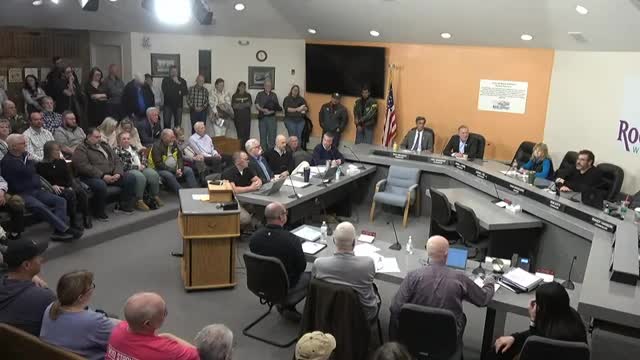Rock Springs leaders press federal abandoned‑mine program as Bitter Creek flood mitigation stalls
February 15, 2025 | Rock Springs City Council, Rock Springs, Sweetwater County, Wyoming
This article was created by AI summarizing key points discussed. AI makes mistakes, so for full details and context, please refer to the video of the full meeting. Please report any errors so we can fix them. Report an error »

Mayor Mickelson described Bitter Creek flood mitigation and said federal Abandoned Mine Lands (AML) officials have determined the work is not their responsibility, leaving the city to manage a large, unresolved flood mitigation project. “Basically, at this point, they have determined that the Bitter Creek is not their problem. And so it has become our problem,” the mayor said.
Why it matters: The Bitter Creek corridor affects downtown neighborhoods and property values; without mitigation the city remains in a floodplain and faces deferred maintenance and redevelopment limits. Speakers said roughly $90–100 million is needed to finish mitigation and remove the area from the floodplain.
AML funding history and local frustration: Officials noted AML previously provided a one‑time distribution (about $4 million) for an early phase of work near a commercial area; subsequent AML decisions left the city without what local leaders consider an appropriate federal partner for the remaining work. The mayor and commissioners said they have lobbied for state help and for clearer AML application processes.
Urban renewal and downtown revitalization: Maria Mortensen, chair of Rock Springs Main Street URA, summarized two decades of downtown investment through facade grants, small-business support and public events, and warned that unresolved floodplain and vacant properties on the east side risk reversing those gains. Mortensen asked city and county officials to consider the long-term costs of leaving parts of downtown undeveloped.
Ending: City leaders said they will continue to press state and federal partners for funding and legal clarification on AML eligibility and urged residents and stakeholders to remain engaged in downtown planning and URA activities.
Why it matters: The Bitter Creek corridor affects downtown neighborhoods and property values; without mitigation the city remains in a floodplain and faces deferred maintenance and redevelopment limits. Speakers said roughly $90–100 million is needed to finish mitigation and remove the area from the floodplain.
AML funding history and local frustration: Officials noted AML previously provided a one‑time distribution (about $4 million) for an early phase of work near a commercial area; subsequent AML decisions left the city without what local leaders consider an appropriate federal partner for the remaining work. The mayor and commissioners said they have lobbied for state help and for clearer AML application processes.
Urban renewal and downtown revitalization: Maria Mortensen, chair of Rock Springs Main Street URA, summarized two decades of downtown investment through facade grants, small-business support and public events, and warned that unresolved floodplain and vacant properties on the east side risk reversing those gains. Mortensen asked city and county officials to consider the long-term costs of leaving parts of downtown undeveloped.
Ending: City leaders said they will continue to press state and federal partners for funding and legal clarification on AML eligibility and urged residents and stakeholders to remain engaged in downtown planning and URA activities.
View full meeting
This article is based on a recent meeting—watch the full video and explore the complete transcript for deeper insights into the discussion.
View full meeting